Ever wondered where your grandfather’s grandfather’s grandfather lived or what he did for a living? Then, Family Tree DNA (FTDNA) is your tool of choice. It was established in 2000 and is regarded as one of the most trusted and reliable providers of DNA testing services. The company started out offering only Y-DNA, mtDNA, and Cohanim DNA tests. Ten years later, the company began offering autosomal testing with its ‘Family Finder’ product, which remains the leading choice among professional genealogists for DNA testing. This product has attracted many genealogists; thus, there is plenty of online support for understanding and using your test results.
FTDNA offers tests for autosomal DNA, YDNA and mTDNA.
This test focuses on the autosomal DNA, which is inherited across generations. With this test, you can:
Family Finder by Family Tree DNA examines over 50,000 markers to trace the ancestral line of the user.
The analysis provides details of the user’s ethnic origin as well.
FTDNA uses a proprietary algorithm to discover individuals who may have a common ancestor within five generations on either side of the user’s family.
The test provides the names and email addresses of closely related individuals to aid in initiating contact.
Since personal information is involved, FTDNA only matches users with others who’ve also opted for the test.
This test is ideal for anyone who wants to learn more about their family’s heritage, culture, or ethnic background.
It matches the user to close relatives and breaks down their ancestor’s origin.
This test reveals the user’s and their family’s unique genetic identity.
You can send your DNA data through a physical kit (supplied by FTDNA) or upload a raw DNA data file from 23andme, MyHeritage, or AncestryDNA.
FTDNA recommends purchasing their kit to avoid missing out on any genetic information the tests might need.
The kit, which you can order on the site, contains:
A basic test, costing $80, takes up to 6 weeks.
More complex tests can take up to 8 weeks.
Once the results are ready, you can access your complete genetic profile.
There are four segments of the Family Finder report
A breakdown of your geographical ancestry and ethnic background.
It contains a map with a ‘My Ancestral History’ panel for historical context on each result.
This feature, available only to people of European descent, searches for genetic matches to reveal migration routes across Europe and other groups that your ancestors may have interacted with.
It also reveals details such as the age at which they would have been living in a given region and the jobs they performed.
A map helps us understand these better.
This service creates a family tree.
It matches your genetic profile to other users and relatives most likely to fall in your maternal or paternal ancestral lines.

Compares matching DNA segments with your genetic matches to reveal areas of similarity.
Chromosome Painter is another tool that helps reveal the ethnic source of each segment of your chromosomes.
The Y chromosome is exclusive to the male gender and is often passed down from the father to the son without much changes in the genetic makeup.
Y-DNA tests the Y chromosome to investigate the male’s paternal family line.
A person taking this test will also receive a ‘Y-DNA haplogroup,’ which uncovers a paternal heritage going back to Africa, the cradle of life.
The following are the available YDNA test options:
| Y-37 | Y-111 | Y-700 |
| Costs $119 | Costs $249 | Costs $449 |
| Studies 37 genetic markers | Studies 111 genetic markers | Studies 700+ markers and 600k+ SNPs |
| Locates distant relatives | Can locate closer relatives | Can locate all relatives within a certain time frame |
| Less detailed migration map | Less detailed migration map | Highly detailed migration map |
Note that these tests are often on sale, with prices sometimes slashed by dozens of dollars.

mtDNA stands for mitochondrial DNA.
A mother passes on this DNA to her children.
Though daughters and sons receive it from their mothers, men cannot pass it on to their children.
This test allows you to explore your direct maternal line and geographic origins.
You also learn about the migration patterns followed by your maternal ancestors.
mtDNA haplogroup uncovers your maternal heritage going back to Africa.
Since mtDNA mutates slowly, this test cannot tell much about your recent maternal generations.
The mtDNA test costs $159 on FTDNA’s website.
This feature, available for all users who have taken the mtDNA test, tells the story of your maternal ancestry and is a fun way to share your results with friends and family.
Since this feature is customizable, you can choose your avatar and provide some information about yourself. Take a look at the sample video below.
This video explains the basic concepts of your mtDNA results with your specific story in mind.
Source: FamilyTreeDNA Youtube channel
In July, MyHeritage announced an integration of FTDNA’s services into their website.
FTDNA’s users could easily transfer their family trees to MyHeritage and continue to build upon them there.
Since FTDNA doesn’t have the range of tools available on MyHeritage, this collaboration benefits users who can extract new insights from their family trees.
Additionally, FTDNA plans to end support for their family tree builder by September 9, 2024.
FTDNA users will be requested to transfer their existing trees to MyHeritage.
In early January, FamilyTreeDNA merged with myDNA, an Australian pharmacogenetics company. FTDNA’s CEO stepped down. MyDNA focuses on lifestyle and wellness aspects like vitamins, minerals, and skincare.
After this merger, FTDNA customers received a “Health & Wellness Discovery Survey” that asked questions about health, fitness, and other lifestyle aspects, not genealogy or ancestry.
This news raises questions about the direction in which FTDNA is headed!
FTDNA is a good choice for people wanting to learn more about their ancestry.
However, there are also some disadvantages to this test:
23andMe and FTDNA enable customers to connect to close relatives.
While 23andMe’s DNA relatives came out in 2009, FTDNA released Family Finder a bit later in 2010.
Although FTDNA has a smaller database, its services surpass those of 23andMe. Features include maternal and paternal lineage tracking, a variety of tests, and a detailed report.
FTDNA provides easy-to-use DNA analysis kits to users who want to learn about their ancestry.
Regarding privacy, FTDNA provides options to opt out of law enforcement matching.
However, completely deleting genetic data or destroying a sample is quite tricky.
If a customer decides to do so, they must contact customer service.
With the tests and services provided, the user can learn about their maternal and paternal ancestry and the potential migration paths of their ancestors, including occupation and location.
Finally, FTDNA enables users to contact close relatives to promote positive relationships.
With features like accepting raw DNA files from other testing services and wellness reports, FTDNA is the better choice for DNA analysis services.
Upload your DNA raw data to Xcode Life to get insights into 700+ health-related traits!
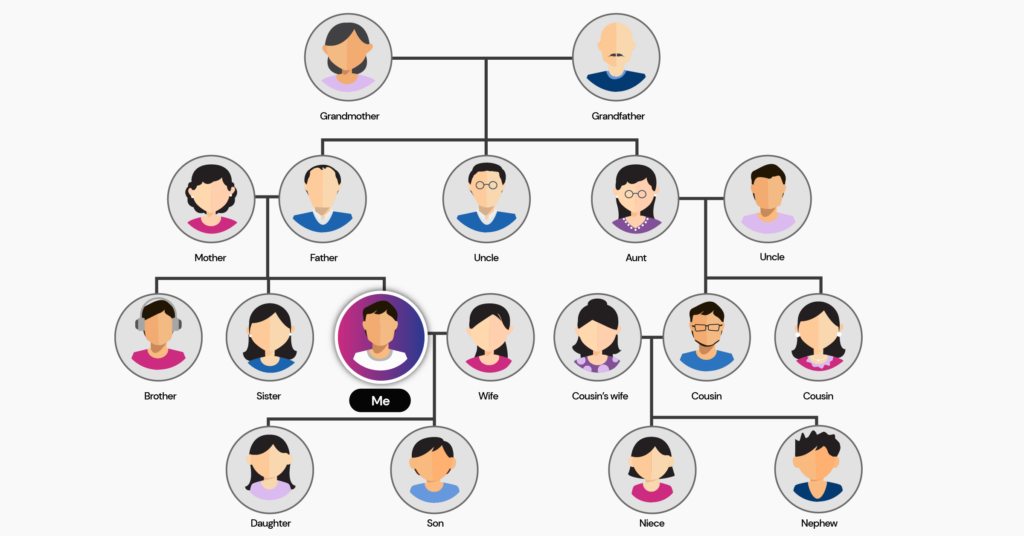
How To Use 23andMe Family Tree?

How To Download Family Tree DNA Raw Data File?

FamilyTreeNow: Free People Finder and Family Tree Builder Tool [2024]
FTDNA has a robust security policy protecting its users' personal information. It also gives users ample control over how their DNA data is processed, shared, and stored.
While FTDNA is one of the best tools available to trace back your maternal and paternal lines, Ancestry’s database and accuracy are much better than those of most of its competitors.
Since different companies use different data and analyze different markers, results can vary between services. Limited data from some remote ethnicities may cause those results to become increasingly vague.
Did you know that approximately 39 million U.S. adults and 936 million people worldwide suffer from a serious form of sleep apnea? With snoring affecting up to 94% of patients, it’s clear that sleep apnea is a widespread issue. But what if your genes influence your risk of developing sleep apnea? Are certain people more likely to suffer from this condition due to inherited traits? And how can you manage and treat sleep apnea if it runs in your family? In this article, we delve into whether sleep apnea is genetic, explore the risk factors, and review the most effective treatments.
Sleep apnea is a disorder characterized by frequent interruptions in breathing during sleep, called apneas, which can last from a few seconds to a minute.
These interruptions disrupt sleep patterns, resulting in fragmented and poor-quality sleep.
The condition can lower blood oxygen levels, straining the cardiovascular system.
Sleep apnea is often undiagnosed because it occurs during sleep, and the individual may be unaware of it.
It is a severe condition that requires medical intervention to prevent long-term health complications.
Sleep apnea is generally classified into three primary categories:
Sleep apnea presents a variety of symptoms, which can differ in their visibility and impact. Key signs include:
Sleep apnea can exhibit different symptoms in children, including:
Recognizing these symptoms can help diagnose and manage sleep apnea effectively.
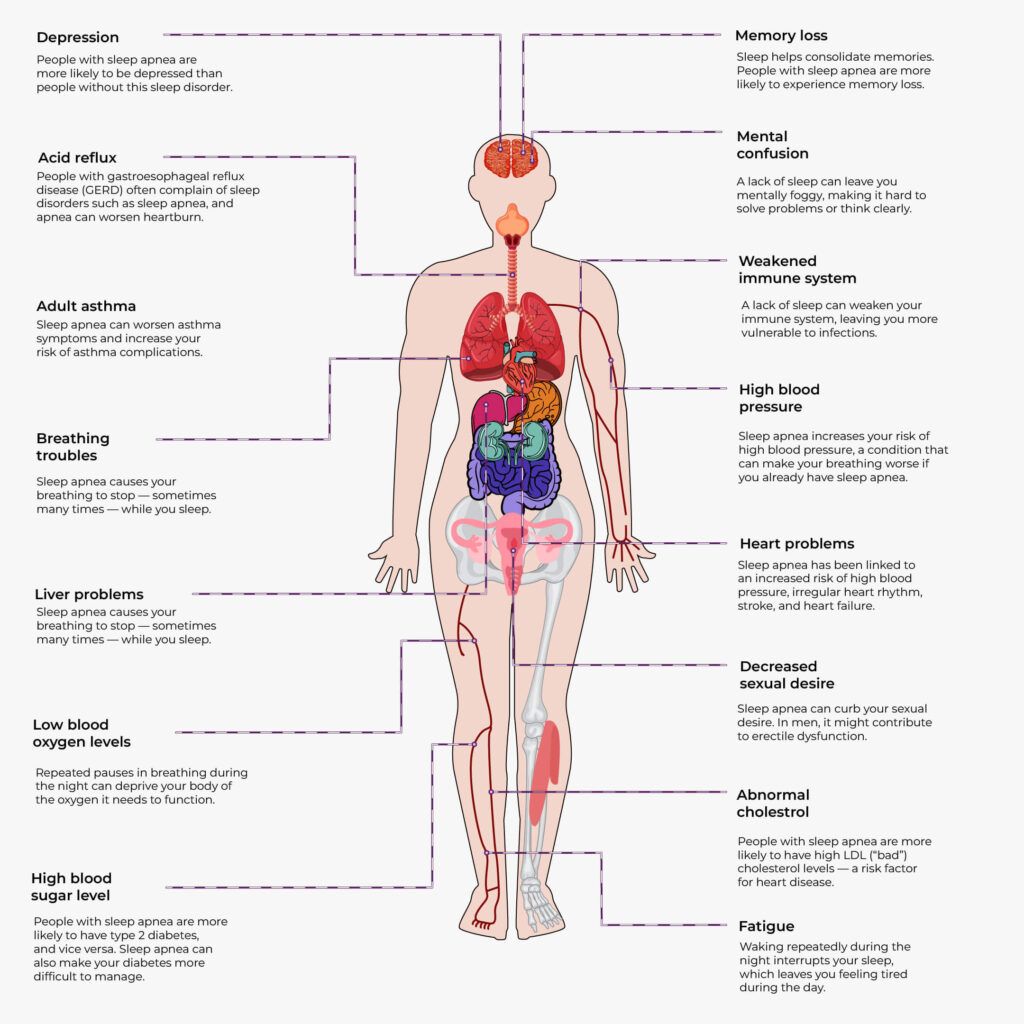
Sleep apnea is a complex trait that has genetic, lifestyle, and environmental influences. No single gene causes sleep apnea. However, the effect of small variations (or changes) in multiple genes combined together can increase the risk of sleep apnea.
| Type of sleep apnea | Genetic link | Details |
| OSA | Strong | Multiple genes contribute to OSA development. Genetics account for approximately 40% of the variation in OSA severity. |
| CSA | Weaker | Possible genetic predisposition, but primarily caused by non-genetic factors like brain respiratory control issues. More research is needed. |
CSA is not known to be inherited, but OSA can run in families. If a parent, sibling, or child has OSA, you’re about 50% more likely to develop it yourself.
CSA is often linked to other medical conditions or certain medications.
In contrast, OSA is linked to genetic traits that affect the structure of your airway, and certain inherited physical features can increase your risk of developing it.
Genetic factors can influence several physiological traits that increase the risk of OSA.
These factors do not directly cause sleep apnea but can make someone more likely to get it.
Key contributors include:
Several genes have been identified as potentially related to sleep apnea:
These genes are linked to physiological processes influencing OSA risk, including responses to hypoxia and airway muscle tone regulation.
Further research is needed to fully understand the role of these genes and their interactions in the development of sleep apnea.
About Xcode Life's Gene Sleep Report
The root cause of sleep apnea varies depending on its type.
Multiple factors can heighten the risk of developing sleep apnea, including both obstructive and central forms:
You can't control your genes, but you can control your lifestyle. Even if you're genetically predisposed to sleep apnea, making healthy choices can significantly lower your risk.
Key measures include:
*The contents of the article are for informational purposes only. Do not stop any medications without consulting your medical practitioner.
Genetic sleep apnea, involving inherited factors that affect the upper airway or respiratory control, can be managed through a combination of lifestyle changes.
Even with its genetic basis, various treatment options exist to address this condition effectively.
Here's an overview of treatment options for genetic sleep apnea:
These management and treatment options can help individuals with genetic sleep apnea lead healthier lives by improving breathing during sleep and addressing related health concerns.

Can Sleep Apnea Lead To Brain Damage?

Sleep Issues: Why Do I Keep Waking Up At 4 AM?

The Top 3 Methods To Fall Asleep Faster
https://www.ncoa.org/adviser/sleep/sleep-apnea-statistics
https://www.nhlbi.nih.gov/health/sleep-apnea
https://www.mayoclinic.org/diseases-conditions/sleep-apnea/symptoms-causes/syc-20377631
https://my.clevelandclinic.org/health/diseases/8718-sleep-apnea
https://www.medicalnewstoday.com/articles/317313
https://www.webmd.com/add-adhd/attention-deficit-hyperactivity-disorder-adhd
https://www.ncbi.nlm.nih.gov/pmc/articles/PMC3917481
https://www.medicalnewstoday.com/articles/178633
While MyHeritage’s DNA testing service may be similar to its older rival, AncestryDNA, its uniqueness lies in its consumer base, mainly European or those interested in their European ancestry. The company is currently testing for 42 different ethnic regions and has around 45 million monthly users, making it a compelling choice for anyone looking at genealogical testing. In this article, we take a deep dive into the service. What do they offer, how does it work, and most importantly, is MyHeritage DNA worth it?
MyHeritage was founded in 2003 by Gilad Japhet.
Initially a simple genealogical service, it soon implemented facial recognition features to help match users’ facial features across populations.
By 2012, the company had expanded massively, surpassing a billion user records, acquiring its competitors, and adding several useful services to its product.
In 2019, MyHeritage DNA acquired both SNPedia and Promethease.
Today, it is a giant in the field of genealogical analysis, with millions of monthly users and billions of user records.
While the kit costs $89 (excluding shipping), it is often on sale.
It includes an ancestry analysis across over 2000 regions.
Additionally, it helps match you to relatives you may not have been aware of.
This pack also costs $89, excluding shipping.
However, it includes a free month-long trial that commences your subscription to the website.
This pack allows access to more features, along with a regional analysis of your genome and a relative searcher service.
You can learn more about your family history and build a family tree.
Billions of historical records are also available upon subscription.
Their latest AI photo tool, called Deep Nostalgia, can animate photos of your ancestors.
It is also made available to subscribers.
After the free trial ends, the first year’s subscription will cost $149.
From the second year onwards, MyHeritage charges a fee of $299.
| MyHeritage DNA Kit | MyHeritage DNA Kit + 30 Day Free Trial |
| Costs $89 | Costs $89 |
| Subscription not included | Subscription included at $150 for the first year and then $299 |
| Offers Ethnicity Estimate and DNA Match | Offers Ethnicity Estimate, DNA Match, family trees, historical records, and Deep Nostalgia |
To order a kit, you must create an account with MyHeritage, which will help deliver your results.
Shipping costs $5 and can take up to 7 business days.
However, paying $19 for shipping can reduce this to 3 business days.
The payment methods include PayPal and paying directly with your credit/debit card.
Instead of collecting your saliva, MyHeritage DNA has two cheek swabs and vials you send off. Here’s what’s in the kit:
MyHeritage has a turnaround of 4 to 6 weeks after the sample arrives at the lab.
That’s faster than competitors AncestryDNA and 23andMe, which require 6 to 8 weeks.
Eventually, the company will mail your results to your registered email address.
The ancestry report contains two main parts, ‘Ethnicity Estimate’ and ‘DNA Matches,’ each with several different features.
Ethnicity Estimate is a detailed breakdown of your unique DNA composition.
Your ethnicity breakdown, covering 42 ethnicities from around the world, is presented in your report both as a map and as a percentage.
You learn about where your ancestors lived, how they migrated, their names and surnames, and the various ethnicities in your lineage.
DNA Matches is a technology that lets you connect with your ‘relatives.’
It compares autosomal DNA test results and family tree data to identify shared genetic sequences that indicate a family relationship.
You can also connect with your newfound ‘relatives’ via MyHeritage.
MyHeritage also allows you to upload your family tree from an existing genealogy program.
Premium users can avail of the following features:
Family Relativity matches to theorize how you are related to your DNA Matches.
Detailed family trees and pedigree charts
A list of common relatives between you and your DNA Match
Common locations shared by your and your DNA Match’s ancestors
AutoClusters that depict several DNA Matches that descended from a common ancestor

You can download your DNA raw data from MyHeritage and learn your genetic risk status for over 50+ health traits and 280+ inherited conditions.
Downloading your raw DNA data is a helpful feature that the company does not advertise as strongly.
You can download your DNA raw data file by following these simple steps.
Important: The link is only valid for 24 hours. If you haven’t used the link within 24 hours, you must start the process again from step 1.
In September 2019, MyHeritage officially announced its acquisition of Promethease and SNPedia.
It was their first customer health acquisition.
The article read, “Promethease will be made free through the end of 2019, and SNPedia will remain a free wiki resource for academic and non-profit use,”.
SNPedia, launched in 2006, is an encyclopedia of single-nucleotide polymorphisms (SNPs).
SNPs are genetic variants, and SNPedia helps link them to medical conditions and traits.
MyHeritage plans to maintain SNPedia as a free resource under the same terms and will utilize this comprehensive knowledge base to enhance future versions of MyHeritage’s DNA health products.
However, the database has not been updated properly for the last few years.
Promethease is a program developed by the SNPedia team that generates a DNA report from users’ raw DNA data files. Promethease reports contain references from all medical and scientific literature.
Promethease currently charges $12 for its service and lets its consumers store their DNA data.
Following the acquisition, MyHeritage temporarily transformed Promethease into a free service.
MyHeritage intends to keep Promethease separate from its MyHeritage DNA health product line.
Unlike Promethease, MyHeritage does not provide health reports based on DNA data uploaded from other vendors.
All of MyHeritage DNA’s health reports are based on clinical validation of the underlying DNA data.
As of November 1st, 2019, the DNA raw data of the existing non-European Promethease users was copied to MyHeritage along with a new account accessible only by the user.
This account also comes with free services like ethnicity estimates and DNA matching for relatives.
Users who did not wish to transfer their DNA data or reports to MyHeritage were invited to delete their accounts before November 2019.
Promethease notified all its users of these changes by email.
People who wish to take a genetic health test or receive health reports are encouraged to purchase tests from MyHeritage DNA.
Previously, MyHeritage DNA offered a Health Kit and an Ancestry Kit.
In 2024, they offer just one DNA Kit.
As mentioned previously, you can purchase this kit either as a standalone or as part of a subscription bundle.
Deep Nostalgia is a new addition to MyHeritage’s suite of photo tools.
This feature allows you to animate the faces of your loved ones in still photos.
It detects faces from old photos and imagines what those people would look like if they had been recorded on video.
You need to create a free account with MyHeritage to avail this feature.
MyHeritage LIVE brings together family history enthusiasts, top international experts, and MyHeritage staff for two days of fascinating lectures covering the latest topics in genealogy and DNA.
Each year, hundreds of MyHeritage users from around the world attend.
MyHeritage LIVE 2020 took place in October 2020 at the Hilton Tel Aviv.

MyHeritage vs 23andMe: Detailed Review and Comparison

Free Tools For 23andMe, AncestryDNA, FTDNA Raw Data Analysis
While for some, not going a day without coffee can cause headaches and dizziness, for a few others, ironically, consuming coffee can cause dizziness. Interesting right? Among other things, our genes play an important role in how our body responds to caffeine - whether it may benefit or harm your health. This article discusses how caffeine may cause dizziness and offers an in-depth guide to how you can moderate your caffeine intake according to your genetic type.
Caffeine is a CNS (central nervous system) stimulant, making us feel energetic and less sleepy upon consumption.
To facilitate this, caffeine does several things to the body:
Here are a few ways by which caffeine might lead to dizziness:
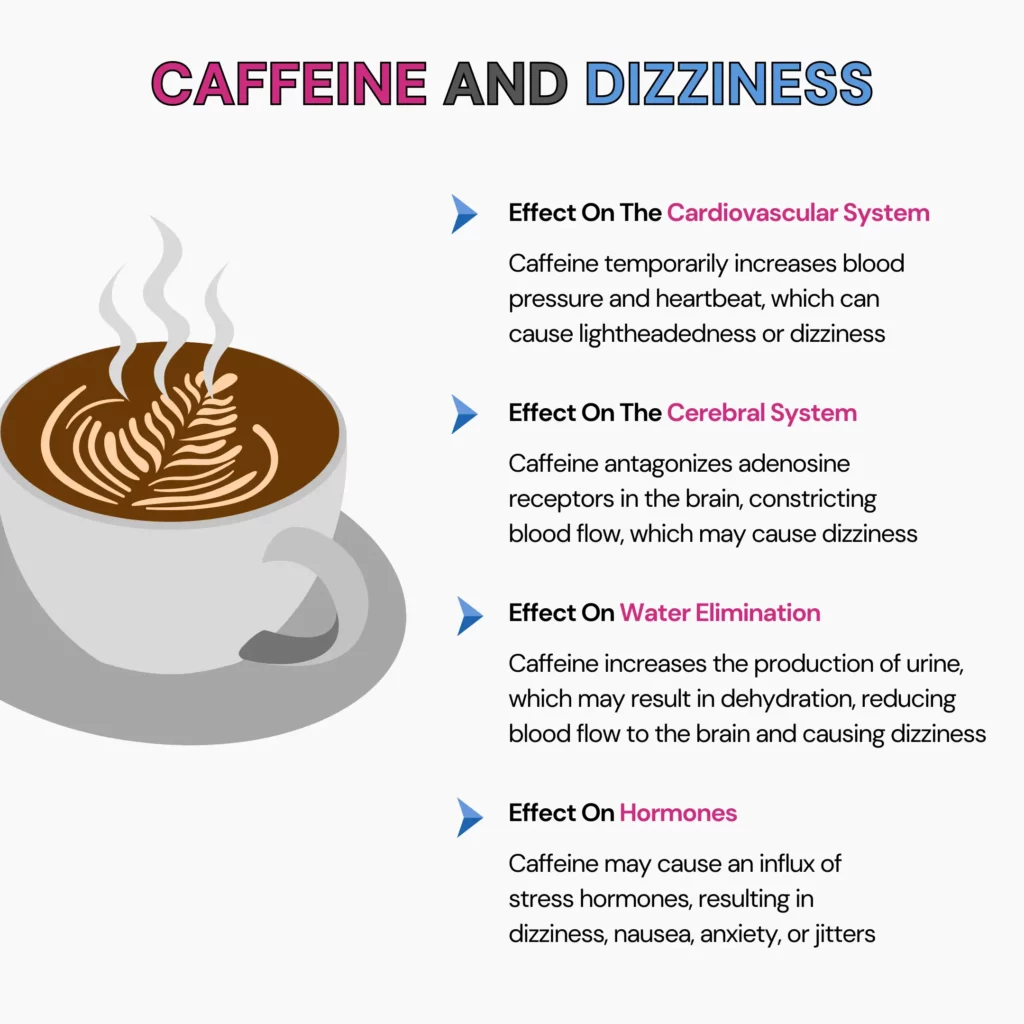
One major pathway by which caffeine can mediate the dizziness effect includes its effect on the cardiovascular system.
Caffeine intake increases blood pressure and heartbeat.
This causes changes in blood flow throughout the body, especially to the brain, which can cause lightheadedness or dizziness.
Caffeine antagonizes adenosine receptors in the brain, constricting blood flow.
This may cause some people to experience dizziness when caffeine is consumed.
Caffeine has a diuretic effect, which increases the production of urine.
Dehydration causes a pressure drop in the body, which reduces blood flow to the brain and may cause dizziness.
Caffeine intake may cause hormonal influx for stress responses, resulting in undesirable side effects like dizziness, nausea, anxiety, and jitters.
Caffeine can affect the cardiovascular system, cerebral blood flow, water elimination, and stress hormone levels. These factors can lead to increased heart rate, blood pressure changes, and reduced brain blood flow, triggering lightheadedness or dizziness.
Caffeine can make us awake and alert as a stimulant, but it can either narrow or swell blood vessels in the brain.
The latter might result in inflammation, which can also expand to nearby tissues, triggering headaches.
Caffeine can also lead to dehydration, which can also be a reason for lightheadedness.
People addicted to caffeine find it challenging to cut down on caffeine.
When a person stops or cuts consuming caffeine then, the very first symptom of caffeine withdrawal is a headache.
Other symptoms, such as tiredness, irritability, and difficulty concentrating, usually accompany caffeine withdrawal headaches.
The FDA has recommended 400 milligrams per day for healthy adults, and it is not associated with any dangerous or adverse effects.
However, this varies with people and how fast they metabolize it when consumed.
Pregnant women should limit their daily caffeine intake to 200 milligrams or less.
Caffeine sensitivity is the degree to which an individual reacts upon caffeine intake.
It varies with person and is influenced by factors like genes, metabolism, age, sex, and the frequency of consumption.
| Metabolizer Types | Recommended Caffeine Intake Per Day |
| Slow metabolizer | 100 mg or up to 1 cup of coffee |
| Moderate metabolizer | 200 mg or up to 2 cups of coffee |
| Fast metabolizer | 400 mg or up to 4 cups of coffee |
People with caffeine sensitivity can metabolize caffeine more slowly than normal people as the adrenaline rushes immediately when they consume it.
Symptoms of consuming higher amounts of caffeine may include:
Consuming too much caffeine can result in
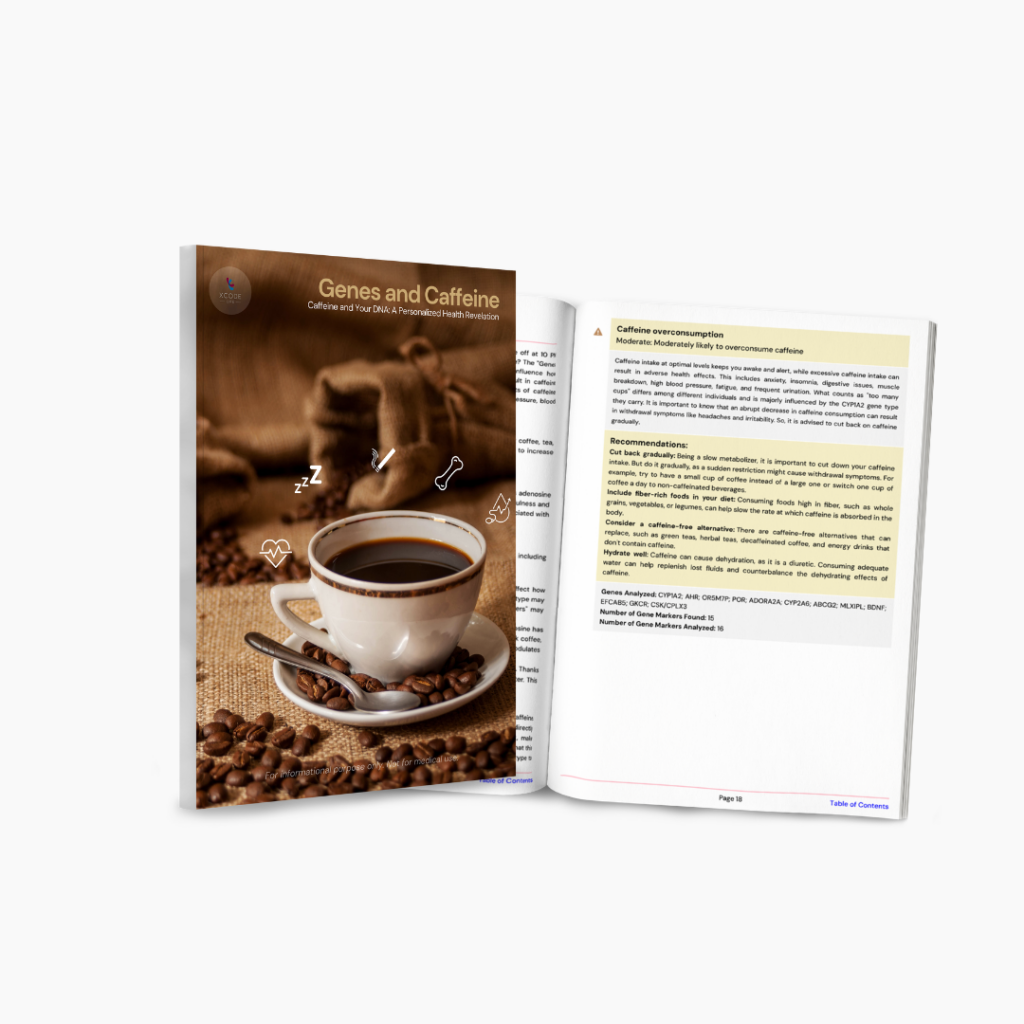
Genes And Caffeine Report
A personalized guide on your body’s relationship with caffeine. Learn if your risk for various health and wellness traits directly linked to caffeine.
Accepted raw data formats: 23andMe, Ancestry DNA, Family Tree DNA, Living DNA, MyHeritage DNA and more.
Stay hydrated: Drinking plenty of water can flush out caffeine and neutralize the diuretic effect of caffeine.
Reduce your caffeine intake: Gradually reduce caffeine intake without an immediate stop.
Try alternatives: Caffeine-containing foods can be replaced with noncaffeinated foods, or if they can’t be avoided, try a darker roast, which contains less caffeine.
Physical movements: Exercising can improve caffeine-induced dizziness. Involving HIIT workouts is not necessary. However, slow movements like yoga or breathing exercises may also help with dizziness.
Eat fiber-rich foods: Fibres can slow down your caffeine absorption. Including fiber-rich foods can help reduce caffeine-induced dizziness.
Caffeine can cause dizziness either by blocking adenosine receptors, or by increasing heart rate, or as a diuretic agent, which leads to dehydration
In addition to its effects on the cardiovascular and cerebral systems, sensation also includes an individual’s sensitivity and hormonal fluctuations
Caffeine can make your head feel weird due to its potential to cause dehydration and withdrawal symptoms
The FDA has recommended a maximum of 400 milligrams of caffeine per day for healthy adults, which also reduces slow metabolizers and pregnant women
Managing caffeine dizziness involves staying hydrated, reducing intake, choosing alternatives, engaging in physical activity, and eating fiber-rich foods

Can Lack Of Sleep Cause Nausea? Know How To Prevent It

How Much Caffeine Is Safe During Pregnancy?

The Coffee Nap Phenomenon: Fad or Fact
https://www.livestrong.com/article/443182-does-caffeine-cause-dizziness
https://www.medsafe.govt.nz/profs/puarticles/caffeine.htm
https://www.fda.gov/consumers/consumer-updates/spilling-beans-how-much-caffeine-too-much
https://www.healthline.com/health/caffeine-sensitivity#hyposensitivity
Marine life holds many secrets to health and wellness. It is, therefore, no surprise that algae and seaweed are being increasingly consumed worldwide today. Another sea vegetable that is harvested for use as a health supplement and as a thickening agent is sea moss. If you’ve heard about sea moss gummies and are wondering how to use them or if you should try them, we’re here to help you! Let’s explore all about sea moss gummies– nutrients, health benefits, and more in this blog!
Sea moss, or Chondrus crispus, is also known by many names, including Irish sea moss and red seaweed.
It grows on the Atlantic coasts between Europe and North America and in many different colors.
It can be consumed in various ways. While sea moss is also available in powder, gel, and pill form, the gummy has taken off!
Like many marine vegetables, sea moss contains several vitamins and minerals.
They are naturally low in fat, calories, and sugar.
They also have a small amount of plant protein.
According to the US FDA, 10 g of sea moss contains the following nutrients:
| Nutrient | Quantity |
| Calories | 4.9 |
| Protein | 0.2 g |
| Fat | 0 g |
| Carbohydrates | 1.2 g |
| Minerals | |
| Calcium | 7.2 mg |
| Magnesium | 14.4 mg |
| Phosphorous | 15.7 mg |
| Potassium | 6.3 mg |
| Iron | 0.9 mg |
| Zinc | 0.2 mg |
Due to the nutrients in sea moss gummies, they are used in health supplements and offer many benefits.
Let’s take a look!
Preliminary research suggests that seaweed and sea moss improves immunomodulation and immune response.
However, more research is required in humans to prove this.
Plant compounds present in some marine vegetation may help fight cancer.
Research published in Cancers reports that fucoxanthin, which is abundantly found in some algae, helps fight specific markers of colorectal cancer or reduce risk factors.
Seaweeds and sea moss are good sources of probiotic bacteria and fiber, which ensure a healthy gut microbiome.
Sea moss is rich in fiber and probiotics, which help maintain a healthy gut.
These create a favorable environment for digestion, relieve constipation, and help cleanse the gut easily.
Seaweed, including sea moss, is rich in dietary fiber, minerals, and vitamins.
These nutrients reduce blood pressure, serum lipids, fatty acids, and blood glucose– all known risk factors for cardiovascular diseases.
Consuming sea moss may help lower your risk for cardiovascular diseases.
Seaweed contains iodine, which is required for thyroid health and function.
So, consuming sea moss may help regulate your thyroid hormones.
*Many of these benefits are still under research and have not been proven conclusively. Please talk to your healthcare practitioner for more information on this and whether it is the right option for you.
There’s a lot of discussion about using sea moss gummies for weight loss.
In a 12-week study, 78 adult volunteers took 1 g (1000 mg) of red seaweed extract daily.
They noticed a significant reduction in total body fat mass and body weight compared to the placebo group.
Another study published in 2015 noted that fucoxanthin, present in seaweed, can break down fat and cause weight loss.
While these studies show the promising effects of sea moss on weight loss, more research is needed to prove this conclusively.
While the potential benefits of sea moss gummies seem exciting, eating them has a few side effects. Let’s take a look!
A component found in seaweed, called poligeenan, may cause the following side effects:
Consuming sea moss in excessive quantities may increase the risk of side effects.
People who should avoid sea moss are:
Here are a few things to remember when taking sea moss gummies:
You may take sea moss gummies daily, but only after consulting your doctor.
Excessive consumption of sea moss can result in gastrointestinal disturbances, increased iodine intake, and, subsequently, thyroid disorders.
You may begin to feel the benefits of sea moss in as little as two weeks after taking it.
However, it may take 3 to 4 weeks before you begin to see the full effects of the supplements.
There is no prescribed time when you should take sea moss supplements.
Ask your doctor about what suits you best.
With the growing popularity of sea moss gummies, there are many brands to choose from.
However, if you choose to prepare your own, here’s how to do that:

Should You Take DGL Supplements For Treating Acid Reflux?
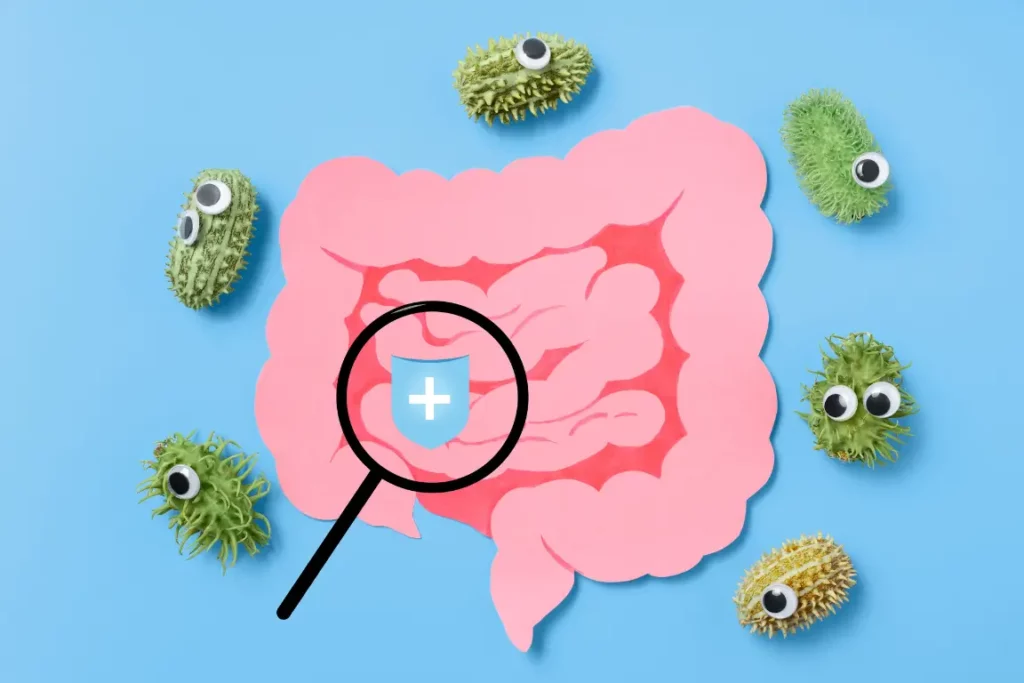
Are Postbiotics Better Than Probiotics For Gut Health?

Is BRAT Diet With Peanut Butter Good For Diarrhea?
Nicotinamide mononucleotide (NMN) is a naturally occurring fountain of youth. It is rapidly gaining popularity as a quick fix for conditions associated with aging, like slower metabolism and poorer skin health. In this article, we investigate this wonder molecule. Is it a magical anti-aging solution? Is there sufficient evidence to support this claim? Read on to find out what NMN is, whether it’s okay to consume, and what NMN benefits could look like.
Nicotinamide mononucleotide (NMN) is a popularly researched nucleotide naturally occurring in the body.
Nucleotides are molecules that play many roles in the body, such as being part of the DNA.
It is a precursor to nicotinamide adenine dinucleotide (NAD), an essential molecule found in every cell in the body, which is known to slow down aging.
Many enzymes and proteins require NAD to perform their functions, including repairing and maintaining DNA. NAD provides energy in the body, helps growth and repair, and may be critical in slowing down the aging process.
Reduced energy levels are one of the many factors responsible for aging.
Increasing NMN intake increases the production of NAD, providing body cells with increased energy production. Taking NMN supplements to raise blood NAD levels naturally has several benefits:
The brain requires an adequate supply of oxygen and nutrients to function.
Studies suggest that NMN supplementation increases blood flow to the brain, improving cognition.
Restoring adequate circulation to the brain can help combat the onset of neurodegenerative conditions like dementia or Alzheimer’s disease.
Muscles lose their ability to regenerate and grow as a result of aging.
A study identified a transport molecule in the brain responsible for muscle health and studied its workings.
The study reported that this transporter could be modulated by reducing or administering nicotinamide mononucleotide.
Thus, NMN may reverse conditions like sarcopenia and improve muscle strength and endurance.
Mitochondria are cell organelles that convert food into energy.
They’re important for energy metabolism and the prevention of metabolic diseases.
Several studies have shown that increased NMN levels in the blood strongly correlate to healthy mitochondria.
Healthy hearts need a constant supply of energy, which comes mostly from mitochondria.
Problems with mitochondria are often seen in failing hearts.
NAD+ is an important molecule for mitochondrial function.
Since NMN is a precursor to NAD+ and can thus support heart health.
This was validated by a study where scientists induced mitochondrial failure to stress the hearts of mice.
Upon injecting NMN, they found that the body quickly converted it to NAD+.
NAD increased the ability of heart cells to work under pressure and slowed the rate of heart cell death.
It was also able to reduce scarring, another contributor to heart dysfunction.
Scientists have extensively studied the benefit of NMN in cancer therapy in rodents.
NMN immunotherapy has increased the efficacy of different therapies used in cancer treatment.
NMN has also been able to reduce the side effects of chemotherapy, such as heart damage and cognitive impairment.
A loss of NAD results in rapid degeneration of the eye's nerves. This may increase the risk of vision loss.
When NMN is replenished in the body, it prevents degeneration of the eye nerves.
A study showed that NMN could protect cells in the eye and reduce inflammation in people with dry eye disease.
Increased age may cause fertility issues in women, like irregular ovulation or implantation failures.
NMN has been shown to improve age-related decline in egg quality and number in female mice.
DNA codes accumulate damage as we age. Repairing DNA damage can prevent age-related diseases and impart an anti-aging quality.
NAD supports enzymes called sirtuins, the guardians of our healthspan.
Sirtuins play an important role in DNA repair by stabilizing telomere length, a sign of aging.
Studies have shown that feeding mice NMN activates sirtuins.
NMN also repairs DNA damage that occurs due to radiation and old age.
Hand-picked Article For You: The Ultimate Guide To Anti-inflammatory Diet + Food List PDF
NMN is the precursor of NAD.
The amount of NAD depends upon the NMN available in the body.
The major differences between NAD and NMN include:
| NMN | NAD | |
| Type | Nucleotide | Coenzyme |
| Function | Increases NAD levels | Regulates metabolism, cell health, circadian rhythm, and organ functioning. |
| Blood absorption | Better | Poorer |
| Effect on mental health | Less effective | More effective |
| Effect on physical health | More effective | Less effective |
NAD is involved in repairing, rebuilding, and protecting DNA from damage.
It has several health benefits, such as:
NAD levels decrease with age or stress, triggering the aging process.
Low NAD levels increase your risk for health conditions like type 2 diabetes, Alzheimer’s, and heart disease.
NAD is sometimes called the ‘fountain of youth’ as it can potentially reverse the effects of aging at a cellular level.
The best way to increase NAD levels is to increase the intake of NMN.
Supplements are popular ways to increase NMN levels in the blood.
NMN occurs naturally in a few dietary sources, such as
Small amounts of NMN also occur in cucumbers, cow milk, and edamame.
The gut readily absorbs NMN. However, more research can help understand how increased NMN intake increases NAD levels in the blood.
If you’re considering NMN supplementation, please consult a medical professional to help make an informed decision.
Nicotinamide mononucleotide is safe. No side effects of NMN supplements have been reported in humans so far.
A long-term study of NMN effects on rodents shows no side effects or toxicity.
A study of NMN in humans shows no safety concerns after administering oral doses of 100, 200, and 500 mg.
There were no changes in heart rate, blood pressure, blood oxygen levels, blood composition, or body temperature.
Hand-picked Article For You: Should You Consider Luteolin Supplementation?
NMN has practically no side effects in humans or animals.
Scientists generally agree that a daily dose of up to 1200mg is safe for human consumption.
NMN helps reduce harmful inflammatory molecules in your body.
Thus, over time, it could smoothen your skin, even out pigmentations, and help your face glow.
Different people will react at different speeds to NMN.
Noticeable changes like better endurance and skin health will only manifest after a month.
You can enjoy its long-term benefits, like DNA repair and cell rejuvenation over the months and years.